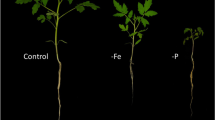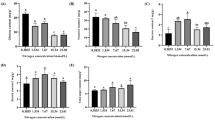Abstract
Nitrogen is one of the crucial macronutrients essential for plant growth, development, and survival under stress conditions. Depending on cellular requirement, plants can absorb nitrogen mainly in multiple forms such as nitrate (NO3 −) or ammonium (NH4 +) or combination of both via efficient and highly regulated transport systems in roots. In addition, nitrogen-fixing symbiotic bacteria can fix atmospheric nitrogen in to NH4 + via highly regulated complex enzyme system and supply to the roots in nodules of several species of leguminous plants. If NO3 − is a primary source, it is transported from roots and then it is rapidly converted to nitrite (NO2 −) by nitrate reductase (NR) (EC 1.6.6.1) which is a critical and very important enzyme for this conversion. This key reaction is mediated by transfer of two electrons from NAD(P)H to NO3 −. This occurs via the three redox centers comprised of two prosthetic groups (FAD and heme) and a MoCo cofactor. NR activity is greatly influenced by factors such as developmental stage and various stress conditions such as hypoxia, salinity and pathogen infection etc. In addition, light/dark dynamics plays crucial role in modulating NR activity. NR activity can be easily detected by measuring the conversion of NO3 − to NO2 − under optimized conditions. Here, we describe a detailed protocol for measuring relative NR enzyme activity of tomato crude extracts. This protocol offers an efficient and straightforward procedure to compare the NR activity of various plants under different conditions.
Access this chapter
Tax calculation will be finalised at checkout
Purchases are for personal use only
Similar content being viewed by others
References
Gojon A (2017) Nitrogen nutrition in plants: rapid progress and new challenges. J Exp Bot 68:2457–2462
Solomonson LP, Barber MJ (1990) Assimilatory nitrate reductase: functional properties and regulation. Annu Rev Plant Biol 41:225–253
Campbell WH (2001) Structure and function of eukaryotic NAD (P) H: nitrate reductase. Cell Mol Life Sci 58:194–204
Stitt M (1999) Nitrate regulation of metabolism and growth. Curr Opin Plant Biol 2:178–186
Bowsher CG, Long DM, Oaks A, Rothstein SJ (1991) Effect of light/dark cycles on expression of nitrate assimilatory genes in maize shoots and roots. Plant Physiol 95:281–285
Kaiser WM, Spill D (1991) Rapid modulation of spinach leaf nitrate reductase by photosynthesis: II. In vitro modulation by ATP and AMP. Plant Physiol 96:368–375
Crawford NM, Smith M, Bellissimo D, Davis RW (1988) Sequence and nitrate regulation of the Arabidopsis thaliana mRNA encoding nitrate reductase, a metalloflavoprotein with three functional domains. Proc Natl Acad Sci USA 85:5006–5010
Wany A, Gupta AK, Aprajita Kumari, Mishra S, Singh N, Pandey S, Vanvari R, Igamberdiev AU, Fernie AR, Gupta KJ (2018) Nitrate nutrition influences multiple factors in order to increase energy efficiency under hypoxia in Arabidopsis. Ann Bot (In Press)
Vishwakarma A, Kumari A, Mur LAJ, Gupta KJ (2018) A discrete role for alternative oxidase under hypoxia to increase nitric oxide and drive energy production. Free Radic Biol Med. https://doi.org/10.1016/j.freeradbiomed.2018.03.045
Pilgrim ML, Caspar T, Quail PH, McClung CR (1993) Circadian and light-regulated expression of nitrate reductase in Arabidopsis. Plant Mol Biol 23:349–364
Castaings L, Camargo A, Pocholle D, Gaudon V, Texier Y, Boutet-Mercey S, Taconnat L, Renou JP, Daniel-Vedele F, Fernandez E, Meyer C (2009) The nodule inception-like protein 7 modulates nitrate sensing and metabolism in Arabidopsis. Plant J 57:426–435
Lee J, He K, Stolc V, Lee H, Figueroa P, Gao Y, Tongprasit W, Zhao H, Lee I, Deng XW (2007) Analysis of transcription factor HY5 genomic binding sites revealed its hierarchical role in light regulation of development. Plant Cell 19:731–749
Planchet E, Jagadis Gupta K, Sonoda M, Kaiser WM (2005) Nitric oxide emission from tobacco leaves and cell suspensions: rate limiting factors and evidence for the involvement of mitochondrial electron transport. Plant J 41:732–743
Kaiser WM, Huber SC (2001) Post-translational regulation of nitrate reductase: mechanism, physiological relevance and environmental triggers. J Exp Bot 52:1981–1989
Lillo C (1994) Light regulation of nitrate reductase in green leaves of higher plants. Physiol Plant 90:616–620
Heidari B, Matre P, Nemi-Feyissa D, Meyer C, Rognli OA, Moller SG, Lillo C (2011) Protein phosphatase 2A B55 and a regulatory subunits interact with nitrate reductase and are essential for nitrate reductase activation. Plant Physiol 156:165–172
Rockel P, Strube F, Rockel A, Wildt J, Kaiser WM (2002) Regulation of nitric oxide (NO) production by plant nitrate reductase in vivo and in vitro. J Exp Bot 53:103–110
Hao F, Zhao S, Dong H, Zhang H, Sun L, Miao C (2010) Nia1 and Nia2 are involved in exogenous salicylic acid-induced nitric oxide generation and stomatal closure in Arabidopsis. J Integr Plant Biol 52:298–307
Sang J, Jiang M, Lin F, Xu S, Zhang A, Tan M (2008) Nitric oxide reduces hydrogen peroxide accumulation involved in water stress-induced subcellular anti-oxidant defense in maize plants. J Integr Plant Biol 50:231–243
Wany A, Kumari A, Gupta KJ (2017) Nitric oxide is essential for the development of aerenchyma in wheat roots under hypoxic stress. Plant Cell Environ 40:3002–3017
Gupta M, Yoshioka H, Ohnishi K, Mizumoto H, Hikichi Y, Kiba A (2013) A translationally controlled tumor protein negatively regulates the hypersensitive response in Nicotianabenthamiana. Plant Cell Physiol 54:1403–1414
Author information
Authors and Affiliations
Editor information
Editors and Affiliations
Rights and permissions
Copyright information
© 2020 Springer Science+Business Media, LLC, part of Springer Nature
About this protocol
Cite this protocol
Bulle, M., Kishorekumar, R., Pathak, P.K., Wany, A., Gupta, K.J. (2020). Measurement of Nitrate Reductase Activity in Tomato (Solanum lycopersicum L.) Leaves Under Different Conditions. In: Gupta, K. (eds) Nitrogen Metabolism in Plants. Methods in Molecular Biology, vol 2057. Humana, New York, NY. https://doi.org/10.1007/978-1-4939-9790-9_3
Download citation
DOI: https://doi.org/10.1007/978-1-4939-9790-9_3
Published:
Publisher Name: Humana, New York, NY
Print ISBN: 978-1-4939-9789-3
Online ISBN: 978-1-4939-9790-9
eBook Packages: Springer Protocols




